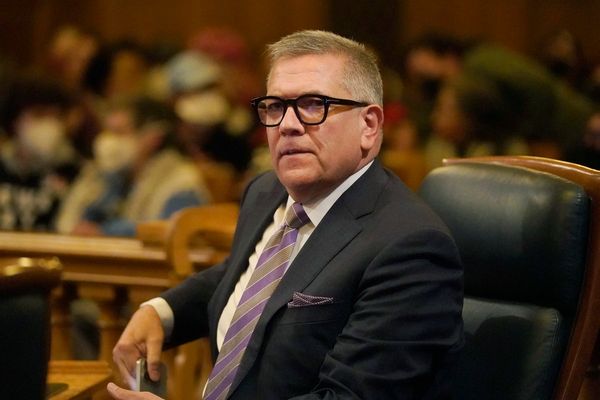
“Why don’t you just take a Xanax?”
That’s what most people suggest when I tell them I’m afraid of flying.
I say I don’t because my doctor told me there’s an increased risk of blood clots. But that’s not the actual reason. I don’t take a sedative, or even drink, on a flight because I must be alert at all times. I can’t possibly be knocked out because when – sorry, if – something goes wrong, I need to be ready to fly the plane. (No, I don’t have a pilot’s licence.)
My fear of flying is like a game of Whac-a-Mole. Once I thwack down one intrusive thought, another even more viscous one pops up. I’ve squinted out of the window, scanning the horizon for rogue planes that might collide with us in midair. Above a vast body of water, I’ve held my hand over my chest, waiting for an impending heart attack. One way I distract myself is by trying to work out if there’s an air marshal on board – the frowning single men playing video games on their phones are usually good candidates.
Turbulence is my biggest trigger. Even if I’ve managed to hold myself together through take-off, the moment we hit a bump I’m a goner. So convinced am I that it’s the end, I start typing out my goodbyes to loved ones on the notes app on my phone.
Catastrophically for me, flights have been getting bumpier. Thanks to the climate crisis, clear air turbulence is now occurring more frequently.
Needless to say, I had zero plans of doing any air travel this summer. But when one of my closest friends invited me to her wedding in New York this past May, I knew it was time to take my first solo long-haul flight in six years.
•••
There aren’t consistent statistics on aviophobia, or fear of flying, with one literature review noting that estimates of its prevalence “range from 2.5% to as high as 40%” of the US population. Back in 2015, Americans’ fears of flying were already at a peak, and travel-related anxiety is only thought to have only worsened since the pandemic. Either way, I knew I was far from alone in my predicament.
The first place I sought help was my therapist. She suggested that perhaps I wasn’t actually afraid of planes or even flying, but something else. Could my fear of flying be a symptom rather than the cause?

She asked about my earliest memories of flying. I was seven and flying as an unaccompanied minor to visit my grandparents in Romania. I had a blue plastic wallet around my neck with all my travel documents in it. I remember being overwhelmed by all of the instructions I was getting, worrying that I’d do something wrong on the plane. At one point, I dinged the bell to call over the flight attendant and asked her if it was OK that there was ice on the window pane.
When it was time for the flight home, after an amazing summer, I cried so hard at the check-in gate where my grandfather was supposed to drop me off that the airport staff let him through security so he could stay with me until it was time to board.
Then there’s that time I flew 20 hours from New York to Nepal in 2015, only to experience a 7.8-magnitude earthquake a few hours after landing in Kathmandu. I reported from overrun hospitals, saw my first dead body and slept under a plastic lawn table in the hotel garden for three nights before managing to get a flight out. It was only once I was in my plane seat that the reality of what I’d just been through hit me.
So maybe flying isn’t the problem – it’s the associations I have with it. Thinking about it like that, it started to make sense why I was so nervous about this particular flight. I thought I was anxious because I hadn’t flown long-haul in a while, but it was actually the destination that was stressing me out. The flight was taking me to New York, a place I once called home and hadn’t returned to in six years.
I lived in New York in my early 20s after uprooting my life in London to do a master’s programme. I thought I’d be gone a year, but I stayed for five. New York looms large in the story of who I am, and I’ve always wondered if I was right to leave. Maybe what I was really afraid of was getting there and realising I’d made a terrible mistake in moving away.
Knowing all this helped me understand why I’m afraid of flying, but it didn’t do much to actually quash the fear. If anything, contemplating the weight of this journey only made me feel worse.
In search of some light relief, I turned to TikTok. I watched a video with 6m likes of a woman putting a scrunched-up napkin into a cup of jelly to demonstrate why turbulence won’t bring down a plane. I followed the affable @almostcaptainmorgan, who posts about her #pilotlife, reviewing the airports she flies into and whether they have a Starbucks or not. But then I started getting served conspiracy theory videos about the MH370 crash and promptly logged off.
Next, I tried using a cheap headset I’d bought to play with a virtual reality app meant to tackle aviophobia, but all it did was make me feel queasy.
It was time to go left field.
•••
A few years ago, I listened to a podcast about why people love watching horror movies. One of the guests described scary movies as cathartic, saying that as an anxious person, she was always waiting for the other shoe to drop. In a horror movie, the other shoe does drop, but you remain safe.
I decided to give it a shot. I asked my partner to pick a horror movie for us to watch. He decided that Scream was probably the most I’d be able to handle. As I sat through Neve Campbell and Courtney Cox trying to unmask the serial killer, I understood what the podcast guest had meant. By the time the credits rolled, I had discharged my anxious energy. And yet, as good as I felt for it, I wasn’t prepared to watch back-to-back horror movies on the plane. No matter the gory details – mid-air collision, medical emergency or turbulence breaking a wing – the core of my fear is always the same. We crash and I die. Painfully and in utter terror.

Thinking back to what my therapist had said, I finally admitted to myself that what I’m really afraid of is death.
“You’re afraid of death? Congratulations! So am I, so is everybody,” Julie McFadden, a California-based hospice nurse, told me over Zoom. McFadden has 1.3 million followers on TikTok, where she makes videos about end-of-life care in order to normalise death and help people be less fearful.
She told me that the secret to a good death was acceptance. “The more you acknowledge the fact that you will die someday, the better you usually live – and the more peacefully you die,” she said.
We talked about the nuances of a fear of dying and a fear of death (the former is about what happens during and the latter is about what happens afterwards, if anything). “We’re built to die and our bodies will take care of us,” she said. She explained how changes in breathing and skin colour look distressing to a loved one but are actually normal physiological responses that help the person pass away comfortably.
I hadn’t thought of it like that before, that the body would know what to do when it was time to go. It was refreshing to be talking so frankly about death. But it also felt like I’d resigned myself to the fact I was definitely going to die on this flight. Had I jinxed myself?
•••
The flight was getting closer and I was really doubting whether I would make it. I wasn’t engaging with any aspect of my trip; I didn’t have an outfit for the wedding, let alone my Esta. I also wasn’t making plans with people because I didn’t want to inconvenience them by not showing up (on account of having died in a plane crash).
In desperation, two weeks before my flight, I called up the British Airways press office to ask if I could get into a simulator and see how pilots train for emergencies. If I could just see how bad it might get on the flight, I’d feel better prepared to handle it. I felt like such a plonker asking this, but the kind press officer didn’t miss a beat: he said they do actually let journalists into flight simulators but there wasn’t enough time to get me on to one before my flight.
He offered instead to send me on a flying with confidence course. Airlines have been running these courses for decades, and I’d actually done one myself five years ago. I remember it being helpful back then, but one pandemic later and I’d forgotten everything I’d learned.
So on a Saturday morning, the day before I was scheduled to fly to JFK airport, I went to a basement conference room in an airport hotel to listen to pilots give a detailed explanation of the physics of flying, the rigours of training and the stellar safety record of the airline industry.
At the end of the presentation on turbulence, in which they kept repeating the mantra “turbulence is uncomfortable but not dangerous”, I went up to one of the pilots to ask him about turbulence getting worse.
“I’ve been flying for over 30 years and I couldn’t tell you if it’s getting worse or it’s just the same,” he said. “And even if it is, it doesn’t matter because the plane is designed to withstand it.”
After lunch, a psychologist explained the psychology of aviophobia and gave us tips for what to do during the flight – mainly taking long out breaths while clenching a large muscle group (your butt cheeks).
The day ended with 150 nervous fliers passing through Heathrow security and boarding a special 30-minute flight that went down to Southampton and back again. The woman sitting next to me said: “I can just see the headline now: ‘Plane carrying nervous fliers crashes’.” I, however, wasn’t worried. In the Final Destination movie of my life, my number was up on the flight to New York.
As the plane hurtled down the runway, the pilot shouted over the speakers: “There’s nothing to fear! The plane is so happy – it’s fulfilling its purpose! Squeeze your bums!”

I got off my training flight and was pumped. I remembered that I’d felt like this the last time I’d done the course – full of encouragement and armed with healthier coping strategies.
I finally felt ready to get on the plane to New York.
•••
I felt OK when my partner dropped me off at the airport. It wasn’t until I got on the jet bridge that I freaked out. I could feel the sting of tears and my breathing get shallow. I couldn’t do this. Could I just turn around and leave, or did I need to tell someone first?
A tidbit from the course came back to me – your anxiety is likely to spike as you board. No kidding. Then I remembered something McFadden, the hospice nurse, said to me about our minds taking care of us in the moment. “Our bodies are these miraculous things that really can take care of us – physically and mentally – in times of crisis,” she said.
I squeezed my bum and shuffled forward, on to the plane.
As the flight took off, I thought about anxiety. When I’m having a panic attack, I think that I’m dying, but it can’t actually kill me. A turbulent flight feels deathly frightening, but it’s not actually dangerous. Just as a plane is designed to withstand turbulence, the body is designed to withstand a panic attack. There was a strange comfort in my new perspective.
I looked out the window. As the houses dropped away, I had one thought: what a terrifyingly beautiful view you can only get from up here.







